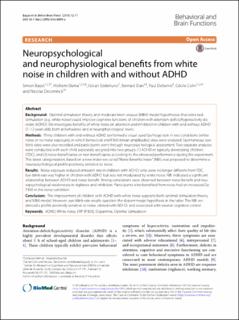| dc.contributor.author | Söderlund, Göran | |
| dc.contributor.author | Baijot, Simon | |
| dc.contributor.author | Slama, Hichem | |
| dc.contributor.author | Dan, Bernard | |
| dc.contributor.author | Deltenre, Paul | |
| dc.contributor.author | Colin, Cécile | |
| dc.contributor.author | Deconinck, Nicolas | |
| dc.date.accessioned | 2023-11-16T10:41:10Z | |
| dc.date.available | 2023-11-16T10:41:10Z | |
| dc.date.created | 2023-11-13T12:40:53Z | |
| dc.date.issued | 2016 | |
| dc.identifier.issn | 1744-9081 | |
| dc.identifier.uri | https://hdl.handle.net/11250/3102940 | |
| dc.description.abstract | Background
Optimal stimulation theory and moderate brain arousal (MBA) model hypothesize that extra-task stimulation (e.g. white noise) could improve cognitive functions of children with attention-deficit/hyperactivity disorder (ADHD). We investigate benefits of white noise on attention and inhibition in children with and without ADHD (7–12 years old), both at behavioral and at neurophysiological levels.
Methods
Thirty children with and without ADHD performed a visual cued Go/Nogo task in two conditions (white noise or no-noise exposure), in which behavioral and P300 (mean amplitudes) data were analyzed. Spontaneous eye-blink rates were also recorded and participants went through neuropsychological assessment. Two separate analyses were conducted with each child separately assigned into two groups (1) ADHD or typically developing children (TDC), and (2) noise beneficiaries or non-beneficiaries according to the observed performance during the experiment. This latest categorization, based on a new index we called “Noise Benefits Index” (NBI), was proposed to determine a neuropsychological profile positively sensitive to noise.
Results
Noise exposure reduced omission rate in children with ADHD, who were no longer different from TDC. Eye-blink rate was higher in children with ADHD but was not modulated by white noise. NBI indicated a significant relationship between ADHD and noise benefit. Strong correlations were observed between noise benefit and neuropsychological weaknesses in vigilance and inhibition. Participants who benefited from noise had an increased Go P300 in the noise condition.
Conclusion
The improvement of children with ADHD with white noise supports both optimal stimulation theory and MBA model. However, eye-blink rate results question the dopaminergic hypothesis in the latter. The NBI evidenced a profile positively sensitive to noise, related with ADHD, and associated with weaker cognitive control. | en_US |
| dc.language.iso | eng | en_US |
| dc.publisher | BioMed Central | en_US |
| dc.rights | Navngivelse 4.0 Internasjonal | * |
| dc.rights.uri | http://creativecommons.org/licenses/by/4.0/deed.no | * |
| dc.title | Neuropsychological and neurophysiological benefits from white noise in children with and without ADHD | en_US |
| dc.type | Peer reviewed | en_US |
| dc.type | Journal article | en_US |
| dc.description.version | publishedVersion | en_US |
| dc.rights.holder | © 2016 Baijot et al | en_US |
| dc.source.volume | 12 | en_US |
| dc.source.journal | Behavioral and Brain Functions | en_US |
| dc.identifier.doi | 10.1186/s12993-016-0095-y | |
| dc.identifier.cristin | 2195738 | |
| dc.source.articlenumber | 11 | en_US |
| cristin.ispublished | true | |
| cristin.fulltext | original | |
| cristin.qualitycode | 1 | |

